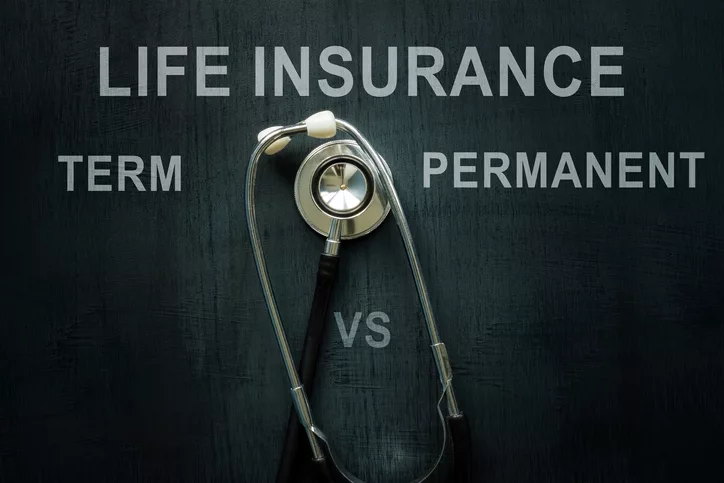
There are several complicated life insurance products available from insurance carriers to support a broad range of consumers. Term and whole life insurance are the most purchased and easiest to comprehend compared to other life insurance policies. So, what’s the difference between the two, and which works best for your needs?
Term Life Insurance
Term life insurance is the simplest and most straightforward form of life insurance. As the name implies, this form of insurance is purchased for a specific period or term, be it five, 10, 20, or 30 years. After the term ends, the policy expires. When someone purchases a term policy, it’s for the sole purpose of receiving a death benefit for their beneficiaries.
Pros and Cons of Term Life Insurance
Since term life insurance is both simple and has a defined term that expires, it tends to be the cheapest—the cost of term life insurance can be substantially lower than other types of life insurance policies. As a result, it can be the most affordable option for families on a budget. It’s also a good option for those solely seeking to provide peace of mind and protection for their beneficiaries upon their death.
Factors that impact the cost of term life insurance include age, health, and gender. The healthier and younger you are, typically, the lower your insurance rates will be. Also, your death benefit amount and term length will also impact the cost of your insurance premiums. A medical exam is also required for many policies available, so health conditions or complications could increase your rates, as well.
An average 35-year-old healthy male will pay approximately $30 monthly for a 20-year term life insurance policy with a $500,000 death benefit payout. In states where it’s permissible, gender can contribute to the cost of life insurance. Since women have a longer life expectancy than men, their policy rates can be lower, so a 20-year term policy with a $250,000 death benefit payout would cost approximately $25.50 monthly for a woman.
The reality is, since term life insurance expires, there’s a high probability that you are only paying for peace of mind—you receive no benefit or cash value if the policy term expires prior to the policyholder’s death. Also, unlike whole life insurance, term life insurance does not provide tax-planning or wealth-building opportunities.
Whole Life Insurance
Unlike term life insurance, whole life insurance is permanent life insurance. If you continue to pay the premiums, the policy never expires. In addition to the death benefit, it also provides you with a cash value opportunity. The cash value funds can be drawn from while the insured is alive.
Pros and Cons of Whole Life Insurance
Most whole life insurance policies provide level premiums, which means the insured pays the same monthly rate throughout the policy’s duration. Premiums are also front-loading, which implies that the cost of whole life insurance will be higher than the cost of the insurance itself when you first purchase it. However, as you age over time, the cost of the policy will be less than the cost of a standard term policy when taking your age into consideration.
Premiums of whole life policies are split between the insurance aspect and the cash value component. The cash value increases on a tax-deferred basis over time, typically at 1% to 2% annually, with most providers. In the future, policyholders can make a withdrawal from the cash value to cover expenses like home repairs, medical fees, and college tuition. The ability to increase its value and withdrawal a tax-free loan makes a whole life policy more appealing than a term policy for those that want to invest or foresee future expenses they might need to cover, respectively. Some providers also offer an unguaranteed dividend that could increase your return on the investment.
Due to the permanent nature of the policy, whole life insurance policies are more costly—5 to 15 times more on average than a term policy—making them out of reach for many in terms of affordability. Also, unlike a term policy that can be canceled at any point in time by simply stopping payments, whole life policy providers often enact a surrender charge of up to 10% of the cash value for those that want to terminate the policy. The surrender charge typically reduces over time until it reaches zero dollars.
Another complexity of whole life insurance is that the death benefit and cash value aspects are tied together. In other words, if you take out a loan against the cash value of the policy, the death benefit will decrease by that amount until you pay the loan back. So, if you don’t pay the loan back prior to your passing, your beneficiary’s death benefit will be the death benefit amount minus the remaining loan value and interest due. For example, if your death benefit is $100,000 and you have a $25,000 loan outstanding against the cash value, the death benefit received by your beneficiaries will be $100,000 minus $25,000, less any interest due.
Which Is Best for Your Needs?
First things first, if you can only afford a term policy compared to a whole life policy, then go for the term life policy to provide at least some peace of mind for you and your loved ones.
If you foresee that you can afford a whole life policy, there are several factors to consider when deciding if a term or a whole life policy is best. The following are scenarios where a whole life policy might work well:
- If you have circumstances that could require you to have access to cash in the future, like a child going to college
- If you’ve already maxed out contributions to a 401(k) or IRA, the tax-free investment of a whole life policy might be ideal to further save for retirement
- If you desire a policy that lasts your entire lifespan due to perpetual circumstances, like having a disabled child
There are also circumstances where a whole life policy might work well for small business partners who would like the ability to purchase a deceased partner’s equity stake in the future.
To determine the best option for your specific circumstances, it’s best to speak with a qualified financial professional.

